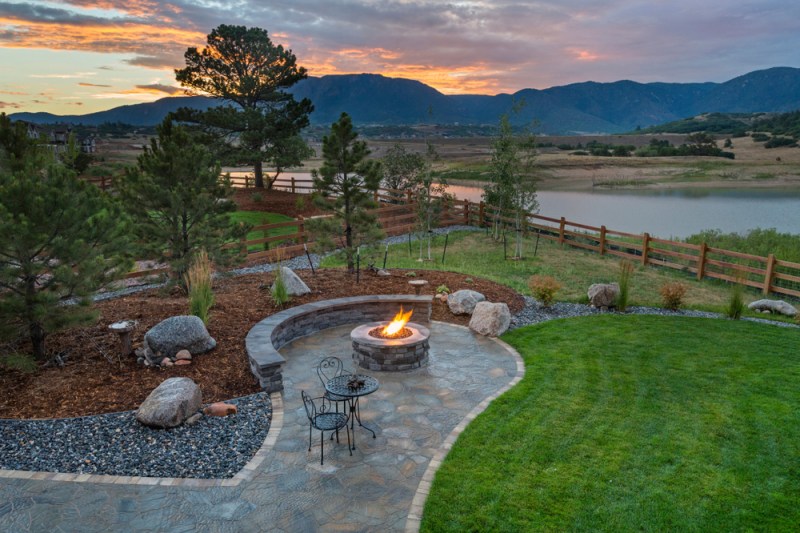We have river rocks bordering our house, but my hubs says mulch would look much better. I’m here to settle the debate.
Bark Mulch Overview

Bark mulch is the most common type of mulch. As the name suggests, it is made from the bark of trees, including cedar, cypress, pine, oak, and hemlock. Landscaping mulch comes in a range of sizes, from finely shredded to large nuggets. Mulch mimics the nutrient-rich, moisture-absorbing ground cover of decaying leaves, twigs, and branches, teeming with fungal, microbial, and insect life as it naturally occurs in the forest. According to Reddi Lawn Maintenance, “Bark mulch is commonly used in flowerbeds and garden beds, and to protect ornamental plants.”
Bark Mulch Pros

Bark mulch undoubtedly adds curb appeal, but it isn’t just for looks. This organic landscaping option is also good for the soil, conserves water, reduces erosion, regulates plant temperature, and prevents weeds. It’s lighter than stone, so it’s easier to work with and can easily be applied by one person using a shovel. It’s also the more affordable of the two, at least in the short-term.
Both mulch and stone reduce weeds by blocking light to the plant. However, according to Kansas State University, placing a mulch ring three to six feet around a tree can almost double its growth rate over time. Bark mulch is also a more convenient option. You can easily find it at home improvement stores, lawn and garden centers, and big-box chain stores.
Bark Mulch Cons

Mulch is the more economical choice in the short term, but in the long term, that may not be so. Unlike rock, mulch starts to look shabby once the sun has bleached it out, the wind has blown it around, and the rains have washed it away. While it’s natural decay is good for the soil, that also means that it will need to be completely removed and replaced at least every few years. Not only does this cost add up over time, but you also have to think about the time and effort that goes into that maintenance.
While it can help deter weeds, too much mulch can suffocate your plants. Greenside Lawn Care warns that “if you mulch too early or too late in the season you could increase the risk of late-blooming or weed growth.” Also, keep in mind that the quality of mulch can vary widely. As EP Henry notes, “Seeds, fly larvae, pine bark, and other nuisances can show up in mulch. It’s best to buy a good quality mulch from a trusted landscape supplier and then apply it right away. Letting mulch sit may attract egg-laying insects you don’t want in your garden.” Finally, if you think about it, bordering your house with mulch is like surrounding your home with kindling. Those in wildfire-prone regions should consider flammability as a con.
Rock Mulch Overview

Granite, lava rock, quartz, pea gravel, and river rock are all types of rock or stone “mulch,” which come in a wide variety of sizes, shapes, textures, and colors. Stone or rock mulch is predominantly used as a border for walkways, driveways, and around buildings.
Rock Mulch Pros

Unlike bark mulch, landscape stone does not decompose. Therefore, it doesn’t require replacement (perhaps just a periodic washing), saving you time and money over the years. This decorative ground cover won’t retain moisture, thereby minimizing the risk of fungi growth. Where rock really stands out is weed control. Combined with landscape fabric, rocks are better than mulch at keeping out weeds. Pesky, persistent weeds may still be able to penetrate, so you’ll still need to weed by hand and use weed killer. Typically rock mulch is more effective at preventing soil erosion than its lighter counterpart. River rocks, sand, crushed gravel, and similar materials are a good choice for those in wildfire-prone zones, as they are fireproof—providing a barrier around buildings, rather than kindling.
Rock Mulch Cons

Since they don’t decay, rocks also don’t provide the nutrients that bark mulches do. In fact, SF Gate advises that “Plants grown under river rock or other inorganic mulch materials may need supplemental feeding.” It’s also heavier, making it harder to maneuver during install and harder to rearrange than mulch. As Reddi Lawn Maintenance observes, “Both the weight of the rocks and the weed barrier make it difficult to replant annuals every year.”
Hardscape also costs more upfront—rock is three to six times more expensive than organic mulches at the point of purchase. However, rocks don’t require replacement, or much maintenance at all, for that matter. EP Henry says you’ll “have to churn the rocks and hose them down once in a while because dust and soil carried by the wind can settle in the spaces between the stones and in turn, host weeds.” Rocks are better than bare soil when it comes to water retention and insulation, but mulch wins on this front as well. According to Greenside Lawn Care, “Some rock types hold heat much longer than others, which can raise soil temperature that in turn puts stress on thirsty plants.”
Conclusion

Rock mulch works well around long-lived trees and shrubs, but in gardens that need fertilizing, mulch is king. Both can signal “no walk” zones to pedestrians, but stone works best to add interest, definition, and transition to hardscaping elements such as walkways and patios. Reddi Lawn Maintenance suggests using rock “around buildings, under decks, around a fire pit, and around swimming pools, and equipment.” Both add an aesthetic appeal that makes your property more attractive. What will hubs and I do? We’ve decided to keep our river rocks, but give them a bath.
